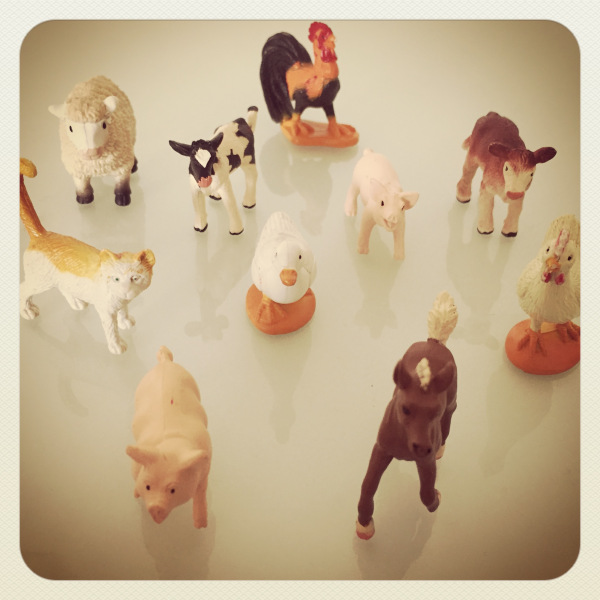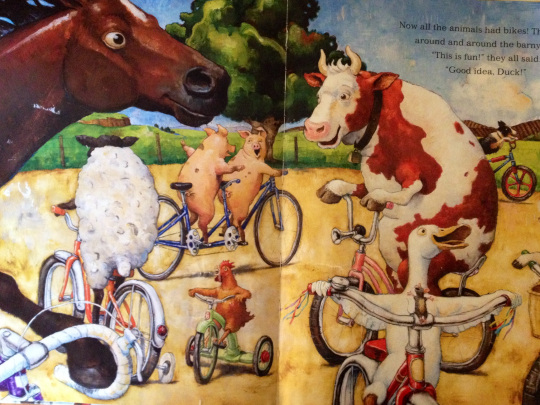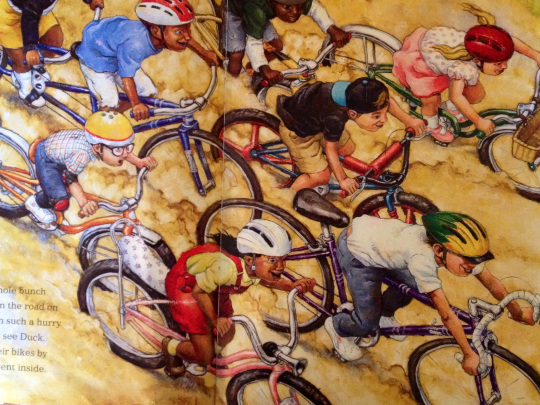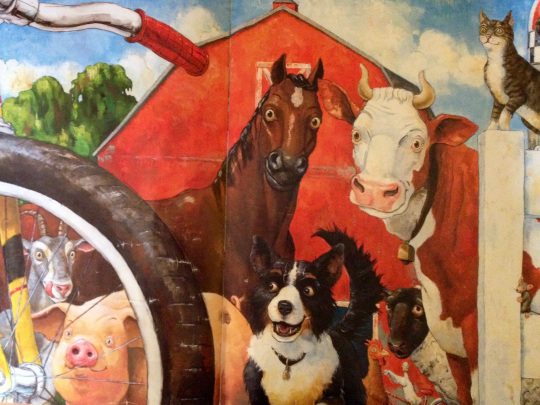Identifying Salient Features: Jasper and the Animals

Jasper is learning from the animals. He names and sorts fake plastic animals, each one carefully described the same way, every time. Giraffe – or G-raff – is tall with a loooong neck and brown spots. Cat has pointy ears, a long tail, and whiskers. Cow has spots, udders and a wide nose. At the zoo, lion, tiger, snow leopard, jaguar are all Cats. Wolf and arctic fox are related to Dog. (salient features, comparative language, categorize, Roman-Lantzy). What makes a dog a Dog. What makes a cat a Cat. Harder than you think it is.
The Challenge of Complex Illustrations
Back in September, I bought Jasper a book called Duck on a Bike by David Shannon. We read it for the first time at bedtime, and Jasper insisted on reading it at least twenty times before falling asleep mid-story. For a child in Phase II CVI, the illustrations were far too complex for him but I longed to read him a real story, to break away from the dozens of board books he had accumulated. While looking at the pages, he assumed the blank unfocused gaze that still crushes me. But he loved the book, so we read it over, and over, and over. Following the story, describing the animals. Jasper began to request the book, “duck on BIIIKE!!” He had read it literally hundreds of times, he had it memorized. I challenged him to look for the animals, indicating either with his eyes or the gesture of his hand toward cow, sheep, goat.
 One day, not too long ago, I quizzed him on one of the more complex pages. Complex for a child with cortical visual impairment. On this particular page, all of the animals are riding bikes. Cow is perhaps one of Jasper’s favorite animals. At the zoo, Jasper wants to go to the family farm to see the miniature panda cattle. When singing Old MacDonald, he names cow first. And when asked to find cow on the page at right, Jasper easily touches cow with his hand. He also finds horse. Then sheep, with his white fluffy body and dark face. And pig and pig. He has found chicken and, only yesterday, dog. He is not yet able to find duck.
One day, not too long ago, I quizzed him on one of the more complex pages. Complex for a child with cortical visual impairment. On this particular page, all of the animals are riding bikes. Cow is perhaps one of Jasper’s favorite animals. At the zoo, Jasper wants to go to the family farm to see the miniature panda cattle. When singing Old MacDonald, he names cow first. And when asked to find cow on the page at right, Jasper easily touches cow with his hand. He also finds horse. Then sheep, with his white fluffy body and dark face. And pig and pig. He has found chicken and, only yesterday, dog. He is not yet able to find duck.
He Can See That...
 In November, around the time Jasper first started seeing the penguins swimming in their pool at the zoo, he amazed me. Near the end of Duck on a Bike, a bunch – Jasper loves that word – a bunch of kids ride up on their bikes. Jasper reached toward the boy wearing the yellow (preferred color) and green bike helmet in the lower right corner and said “hat,” touching the boy’s bike helmet. (He knows bike helmets because of mommy’s bike helmet “hat.”) He can see that…he can see that, was the only thing going through my mind. Jasper can find the red helmet, and the blue baseball cap. All of these kids are on the right side of the page, in Jasper’s right visual field, his preferred field. The field that is intact.
In November, around the time Jasper first started seeing the penguins swimming in their pool at the zoo, he amazed me. Near the end of Duck on a Bike, a bunch – Jasper loves that word – a bunch of kids ride up on their bikes. Jasper reached toward the boy wearing the yellow (preferred color) and green bike helmet in the lower right corner and said “hat,” touching the boy’s bike helmet. (He knows bike helmets because of mommy’s bike helmet “hat.”) He can see that…he can see that, was the only thing going through my mind. Jasper can find the red helmet, and the blue baseball cap. All of these kids are on the right side of the page, in Jasper’s right visual field, his preferred field. The field that is intact.
 It gets tougher. It would seem easy enough to identify the animals on the page at left. But this page is different. Compare it with the other pages shown. Here the animals face the viewer straight on. They are not pictured this way anywhere else in the book. The animals look different here and prove challenging for Jasper. Until a few days ago, he could not respond when asked to find cow. He would say, “Huh…” his word for I don’t know. And quickly turn to the next page, where he knows he can find cow, large and in profile, as Jasper is used to seeing him. Jasper still does not point with a finger but he touches cow with his hand.
It gets tougher. It would seem easy enough to identify the animals on the page at left. But this page is different. Compare it with the other pages shown. Here the animals face the viewer straight on. They are not pictured this way anywhere else in the book. The animals look different here and prove challenging for Jasper. Until a few days ago, he could not respond when asked to find cow. He would say, “Huh…” his word for I don’t know. And quickly turn to the next page, where he knows he can find cow, large and in profile, as Jasper is used to seeing him. Jasper still does not point with a finger but he touches cow with his hand.
Next Steps
So far, Jasper can find cow and horse. The goal is finding mouse. Well… the goal is reading sight words. The goal is spotting zebras in the African Savannah at the zoo, one of Jasper’s favorite places. Keeping track of mommy in public. Riding a bike. An academic track at school. University.
For now, we practice. Jasper and the animals.
Originally published 1/21/2014 at oneinfourthousand.wordpress.com.

